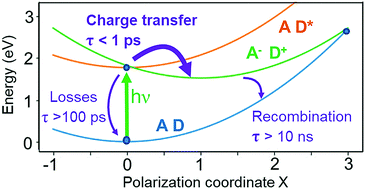当前位置:
X-MOL 学术
›
Energy Environ. Sci.
›
论文详情
Our official English website, www.x-mol.net, welcomes your feedback! (Note: you will need to create a separate account there.)
Designing high performance all-small-molecule solar cells with non-fullerene acceptors: comprehensive studies on photoexcitation dynamics and charge separation kinetics†
Energy & Environmental Science ( IF 32.5 ) Pub Date : 2017-12-12 00:00:00 , DOI: 10.1039/c7ee02967e Junqing Shi 1, 2, 3, 4, 5 , Anna Isakova 1, 2, 3, 4, 5 , Abasi Abudulimu 1, 2, 3, 4, 5 , Marius van den Berg 6, 7, 8, 9 , Oh Kyu Kwon 10, 11, 12, 13, 14 , Alfred J. Meixner 6, 7, 8, 9 , Soo Young Park 10, 11, 12, 13, 14 , Dai Zhang 6, 7, 8, 9 , Johannes Gierschner 1, 2, 3, 4, 5 , Larry Lüer 1, 2, 3, 4, 5
Energy & Environmental Science ( IF 32.5 ) Pub Date : 2017-12-12 00:00:00 , DOI: 10.1039/c7ee02967e Junqing Shi 1, 2, 3, 4, 5 , Anna Isakova 1, 2, 3, 4, 5 , Abasi Abudulimu 1, 2, 3, 4, 5 , Marius van den Berg 6, 7, 8, 9 , Oh Kyu Kwon 10, 11, 12, 13, 14 , Alfred J. Meixner 6, 7, 8, 9 , Soo Young Park 10, 11, 12, 13, 14 , Dai Zhang 6, 7, 8, 9 , Johannes Gierschner 1, 2, 3, 4, 5 , Larry Lüer 1, 2, 3, 4, 5
Affiliation

|
Solution-processable all-small-molecule organic solar cells (OSCs) have shown dramatic progress in improving stability and photovoltaic efficiency. However, knowledge of photoexcitation dynamics in this novel class of materials is very limited. To fully exploit the design capacities inherent in small molecule chemistry, the elementary processes and branching yields must be known in detail. Here, we present a combined computational–experimental study of photoexcitation dynamics of a prototypical all-small-molecule photovoltaic blend, p-DTS(FBTTh2)2 as a donor and NIDCS-MO as an acceptor. Femtosecond spectroscopy data show that excitonic coupling is small and that the charge transfer states are localized, at first glance contradicting the high internal quantum efficiency (IQE) and open circuit voltage (VOC) of this material. A target analysis of the femtosecond spectra yields exciton dissociation rates of 1/(25 ps) and 1/(100 ps) for the as-deposited and annealed blend, respectively. These rates are far slower than in typical polymer based organic solar cells. Still, internal quantum yields are high because parasitic quenching processes are found to be even slower. In the framework of semiclassical Marcus theory, we demonstrate that our system shows near-optimum energy conversion and charge separation yields, due to negligible activation energy for charge generation but high activation energy for charge recombination, allowing enough time to separate localized charge transfer states. We thus justify both the high internal quantum yields and the high open circuit voltage found in this system. Finally, we predict that highly efficient and stable low-optical bandgap systems can be realized by reducing the electronic coupling between the donor and acceptor.
中文翻译:

设计具有非富勒烯受体的高性能全小分子太阳能电池:光激发动力学和电荷分离动力学的综合研究†
可溶液处理的全小分子有机太阳能电池(OSC)在提高稳定性和光伏效率方面显示出显着进步。但是,这种新型材料中光激发动力学的知识非常有限。为了充分利用小分子化学固有的设计能力,必须详细了解基本过程和支化产率。在这里,我们提出了一种典型的全小分子光伏混合物p-DTS(FBTTh 2)2的光激发动力学的组合计算实验研究。作为捐赠者,NIDCS-MO作为接受者。飞秒光谱数据表明,激子耦合很小,并且电荷转移状态局部化,乍一看与高内部量子效率(IQE)和开路电压(V OC)相矛盾)的材料。飞秒光谱的目标分析表明,沉积和退火混合物的激子解离速率分别为1 /(25 ps)和1 /(100 ps)。这些速率远比典型的基于聚合物的有机太阳能电池慢。但是,内部量子产率仍然很高,因为发现寄生猝灭过程甚至更慢。在半经典Marcus理论的框架内,我们证明了我们的系统显示出近乎最佳的能量转换和电荷分离产率,这是因为电荷产生的活化能可忽略不计,而电荷重组的活化能却很高,从而有足够的时间来分离局部电荷转移状态。因此,我们证明了在该系统中发现的高内部量子产率和高开路电压都是合理的。最后,
更新日期:2017-12-12
中文翻译:

设计具有非富勒烯受体的高性能全小分子太阳能电池:光激发动力学和电荷分离动力学的综合研究†
可溶液处理的全小分子有机太阳能电池(OSC)在提高稳定性和光伏效率方面显示出显着进步。但是,这种新型材料中光激发动力学的知识非常有限。为了充分利用小分子化学固有的设计能力,必须详细了解基本过程和支化产率。在这里,我们提出了一种典型的全小分子光伏混合物p-DTS(FBTTh 2)2的光激发动力学的组合计算实验研究。作为捐赠者,NIDCS-MO作为接受者。飞秒光谱数据表明,激子耦合很小,并且电荷转移状态局部化,乍一看与高内部量子效率(IQE)和开路电压(V OC)相矛盾)的材料。飞秒光谱的目标分析表明,沉积和退火混合物的激子解离速率分别为1 /(25 ps)和1 /(100 ps)。这些速率远比典型的基于聚合物的有机太阳能电池慢。但是,内部量子产率仍然很高,因为发现寄生猝灭过程甚至更慢。在半经典Marcus理论的框架内,我们证明了我们的系统显示出近乎最佳的能量转换和电荷分离产率,这是因为电荷产生的活化能可忽略不计,而电荷重组的活化能却很高,从而有足够的时间来分离局部电荷转移状态。因此,我们证明了在该系统中发现的高内部量子产率和高开路电压都是合理的。最后,



























 京公网安备 11010802027423号
京公网安备 11010802027423号